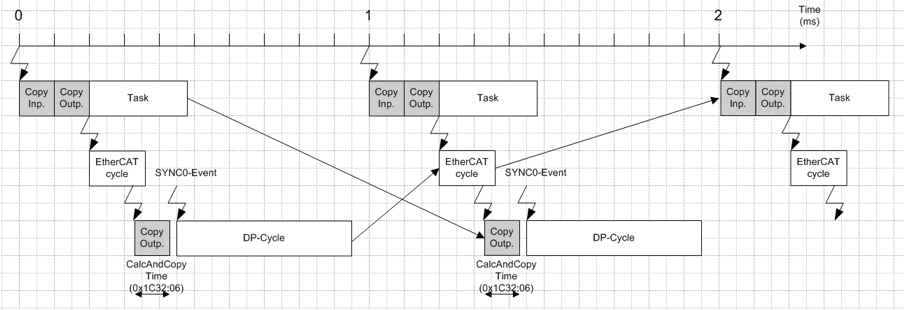PROFIBUS MC
The difference between PROFIBUS MC and PROFIBUS DP is that the PROFIBUS cycle is constant, with a jitter of a few microseconds (for PROFIBUS DP, the jitter is greater than 100 µs), and at the start of the cycle a broadcast global control telegram is sent, which can be used by the MC slaves for synchronization. This enables precise synchronization of drive control loops with the NC.
However, this precise synchronization means that bus disturbances, switching off of slaves, pulling of bus plugs etc. will usually lead to a loss of synchronicity between master and slave, since the bus timing is changed.
DP/MC Equidistant Mode
In order to operate the EL6731 with PROFIBUS MC, the Operation Mode "DP/MC (equidistant)" must be set on the tab "EL6731" (for TwinCAT) of the master. Whichever task uses the equidistant functionality of the EL6731 (most often this is the NC task) should have the highest priority, as otherwise the synchronicity can be disturbed.
The EL6731 generally runs in Sync Master mode, EtherCAT synchronized via the distributed clocks, using DC Optimized mode. The shift time in the distributed clock settings of the EtherCAT master must be equal or greater than the CalcAndCopy time of the EL6731. The CalcAndCopy time of the EL6731 depends on the number of configured DP slaves, although it can be measured in OPERATIONAL state (set entry 0x1C32:08 to 1, then read entry 0x1C32:06). The following diagram shows the cycle for a task with IO at the start of the task:

Setting of Equidistant Times
The button Calculate MC-Times (TwinCAT; see tab MC) can be used to set all equidistant parameters automatically.
Diagnosis of Equidistant Times
The MC-Diag tab in the System Manager or ADS in the control program is available for diagnosing the equidistance times (see section Master diagnostics).